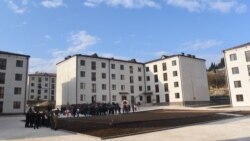Nagorno-Karabakh’s economy grew by an estimated 9 percent in 2019, continuing a more than decade-long rapid expansion, according to officials in Stepanakert.
The Karabakh government’s latest growth projections released last week show that the Armenian-populated territory’s Gross Domestic Product was on course to total 341 billion drams ($713 million). The resulting GDP per capita of more than $4,800 would be slightly higher than in Armenia.
The Karabakh economy was worth just 70 billion drams in 2008. Official figures indicate that it has since grown by around 10 percent annually in real terms, despite the lingering risk of a renewed Armenian-Azerbaijani war for the disputed territory.
Speaking at a year-end news conference in Stepanakert, the Karabakh state minister, Grigory Martirosian, said growth was primarily driven by trade and services in January-September 2019.
Martirosian also reported significant increases in manufacturing and electricity production. Karabakh’s overall industrial output accounted for around 30 percent of GDP, the Artsakhpress news agency quoted him as saying. A large part of that output is generated by a copper and molybdenum mine located in the northern Martakert district.
Government data cited by Martirosian shows that nearly one-fifth of electricity produced in Karabakh was exported to Armenia in 2019.
In the words of Bako Sahakian, the Karabakh president, Karabakh gained “energy self-sufficiency” in 2017. That was made possible by the construction of 31 small hydroelectric plants on the mountainous region’s fast-flowing rivers. A dozen more such plants are reportedly under construction now.
Speaking at a December 23 meeting in Yerevan of Armenia’s and Karabakh’s leaders, Sahakian also said that Karabakh has become a major wheat exporter. “In 2019, we produced 112,000 tons of wheat, which is twice as much as our internal demand,” he said.
Despite its robust economic growth, Karabakh remains very dependent on annual subsidies from Armenia’s government. They will finance just over half of the Karabakh government’s 2020 budgetary expenditures projected at 120 billion drams ($250 million).
The subsidies include proceeds from import duties on non-Armenian goods that are shipped to Karabakh but collected by Armenia’s customs service.






Facebook Forum